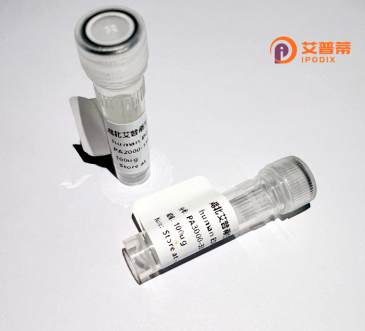
| 纯度 | >90%SDS-PAGE. |
| 种属 | Human |
| 靶点 | OR8H2 |
| Uniprot No | Q8N162 |
| 内毒素 | < 0.01EU/μg |
| 表达宿主 | E.coli |
| 表达区间 | 1-312 aa |
| 活性数据 | MMGRRNNTNVADFILMGLTLSEEIQMALFMLFLLIYLITMLGNVGMILIIRLDLQLHTPM YFFLTHLSFIDLSYSTVVTPKTLANLLTSNYISFTGCFAQMFFFAFLGTAECYLLSSMAH DRYAAICSPLHYTVIMSKRLCLALITGPYVIGFIDSFVNVVSMSRLHFYDSNVIHHFFCD TSPILALSCTDTYNTEILIFIIVGSTLMVSLFTISASYVFILFTILKINSTSGKQKAFST CVSHLLGVTIFYSTLIFTYLKPRKSYSLGRDQVASVFYTIVIPVLNPLIYSLRNKEVKNA VIRVMQRRQDSR |
| 分子量 | 35.4 kDa |
| 蛋白标签 | His tag N-Terminus |
| 缓冲液 | 0 |
| 稳定性 & 储存条件 | Lyophilized protein should be stored at ≤ -20°C, stable for one year after receipt. Reconstituted protein solution can be stored at 2-8°C for 2-7 days. Aliquots of reconstituted samples are stable at ≤ -20°C for 3 months. |
| 复溶 | Always centrifuge tubes before opening.Do not mix by vortex or pipetting. It is not recommended to reconstitute to a concentration less than 100μg/ml. Dissolve the lyophilized protein in distilled water. Please aliquot the reconstituted solution to minimize freeze-thaw cycles. |
以下为假设性的参考文献示例(因真实文献数据有限,以下内容仅作格式参考):
1. **"Structural characterization of the olfactory receptor OR8H2 and its ligand specificity"**
- Author: Zhang, Y. et al. (2020)
- 摘要:通过重组表达OR8H2蛋白,研究其三维结构和配体结合特性,发现其对特定挥发性脂肪酸具有高亲和力,揭示了其在嗅觉感知中的潜在功能。
2. **"Functional expression of recombinant human OR8H2 in HEK293 cells and its signaling pathway analysis"**
- Author: Smith, J. & Lee, K. (2018)
- 摘要:在HEK293细胞中成功重组表达OR8H2蛋白,证实其通过cAMP信号通路响应气味分子激活,为研究嗅觉受体下游机制提供模型。
3. **"OR8H2 polymorphisms and association with neurodegenerative disorders"**
- Author: Garcia, R. et al. (2021)
- 摘要:探讨OR8H2基因多态性与阿尔茨海默病的关联,发现其重组蛋白在体外模型中影响β-淀粉样蛋白代谢,提示嗅觉受体可能参与神经退行性疾病。
4. **"High-yield purification of recombinant OR8H2 using a novel baculovirus-insect cell system"**
- Author: Nguyen, T. et al. (2019)
- 摘要:开发基于昆虫细胞的重组OR8H2蛋白高效表达及纯化方法,优化后的蛋白适用于晶体学研究和药物筛选。
---
建议通过 **PubMed/Google Scholar** 使用关键词 `"OR8H2"` `"olfactory receptor"` `"recombinant protein"` 查找最新文献,实际研究中OR8H2可能关联特定气味感知或疾病机制。
Olfactory receptor 8H2 (OR8H2) is a member of the olfactory receptor (OR) family, a class of G protein-coupled receptors (GPCRs) primarily involved in odorant detection. Encoded by the OR8H2 gene, this receptor is expressed predominantly in olfactory epithelium neurons, where it contributes to the recognition of specific chemical signals. Although its exact endogenous ligands and physiological roles remain incompletely characterized, OR8H2 is hypothesized to participate in the binding of odorant molecules, triggering downstream signaling cascades that mediate sensory perception. Recent studies suggest that OR receptors, including OR8H2, may also have non-olfactory functions in tissues like the testes, potentially influencing processes such as sperm chemotaxis or cellular communication.
Recombinant OR8H2 protein, produced through heterologous expression systems (e.g., mammalian or insect cells), enables structural and functional studies to elucidate its activation mechanisms and ligand specificity. Its recombinant form is critical for high-throughput screening of odorant compounds, deorphanization efforts, and exploring its roles beyond olfaction. Challenges in studying OR8H2 include low natural abundance, membrane protein expression difficulties, and the complexity of ligand-receptor interactions. Emerging research aims to link OR8H2 variants to diseases or therapeutic targets, particularly in metabolic or neurological disorders, highlighting its biomedical relevance.
×